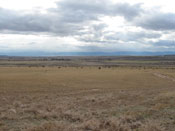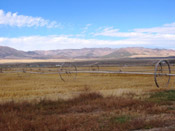Beneficial Use Matrix — Agriculture Use
Agriculture is the major user of water in the United States and can generally accept a lower water quality than municipal users. Salinity, sodium adsorption ratio (SAR), and other toxic constituents are major concern for agricultural uses. This page provides information about the limitations of using CBM produced water for agricultural purposes.
Livestock Watering
In several basins, CBM produced water has been used for livestock watering. Animals are able to ingest a wide variety of different water qualities without adverse health effects. However, highly saline water or water containing toxic chemicals may be hazardous to animals and may even render the milk or meat unfit for consumption.
In evaluating the suitability of produced water for livestock watering, a number of factors should be considered, including water quality, local conditions, availability of alternate supplies, seasonal changes, and age and health conditions of the animals. Considering the above factors and the need to minimize any risk of economic losses, the United Nations Food and Agriculture Organization (FAO) established a water quality guide for livestock and poultry uses1. The basic FAO guidelines should be met at all times. In some cases, local factors, such as the effects of evaporation and concentration, must also be considered. It is often necessary in arid and semi-arid regions that water quality for livestock watering is higher than the basic guidelines set by the FAO.
Crop Irrigation
Water quality has a dramatic effect on soil productivity and crop health. The major water quality parameters for crop irrigation include salinity, sodium adsorption ratio (SAR), pH, alkalinity (carbonate and bicarbonate), and concentrations of specific ions (i.e., chloride, sulfate, boron, and nitrate-nitrogen (NO3-N)). Other irrigation water constituents that may affect suitability for agricultural use include heavy metals and microbial contaminants.
The FAO suggests various water quality criteria for general irrigation1. The water quality characteristics of CBM produced water can be compared to generally accepted irrigation water quality requirements.
The US EPA also provides recommended limits for constituents in irrigation water from reclaimed facilities2 [PDF].
References
- Ayers, R. S., Westcot, D. W., Water quality for agriculture, 1994, Irrigation and Drainage Paper, 29 Rev. 1, http://www.fao.org/DOCREP/003/T0234E/T0234E00.htm#TOC
- US EPA, 2004, Guidelines for water reuse, EPA/625/R-04/108.



